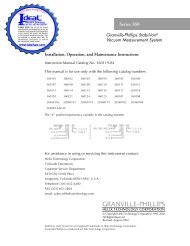Leybold D65BCS, D40BCS, Instruction Manual - Ideal Vacuum ...
Leybold D65BCS, D40BCS, Instruction Manual - Ideal Vacuum ...
Leybold D65BCS, D40BCS, Instruction Manual - Ideal Vacuum ...
Create successful ePaper yourself
Turn your PDF publications into a flip-book with our unique Google optimized e-Paper software.
Maintenance<br />
3.8 <strong>Leybold</strong> Service<br />
If a pump is returned to <strong>Leybold</strong>, indicate whether the<br />
pump free of substances damaging to health or whether<br />
it is contaminated. If it is contaminated also indicate the<br />
nature of the hazard. For this you must use a form which<br />
has been prepared by us which we will provide upon<br />
request.<br />
A copy of this form is reproduced at the end of these<br />
Operating <strong>Instruction</strong>s: “Declaration of Contamination of<br />
<strong>Vacuum</strong> Instruments and Components”.<br />
Please attach this form to the pump or enclose it with the<br />
pump.<br />
This “Declaration of Contamination” is required to meet<br />
German Law and to protect our personnel.<br />
<strong>Leybold</strong> must return any pumps without a “Declaration of<br />
Contamination” to the sender’s address.<br />
Warning<br />
The pump must be packed in such a way,<br />
that it will not be damaged during shipping<br />
and so that any contaminants are not released<br />
from the package.<br />
3.9 Storing the Pump<br />
Caution<br />
Before putting a pump into operation once<br />
more it should be stored in a dry place preferably<br />
at room temperature (20 °C = 68 °F).<br />
Before the pump is shelved it must be properly<br />
disconnected from the vacuum<br />
system, purged with dry nitrogen and the oil<br />
should be changed too.<br />
The inlets and outlets of the pump must be<br />
sealed with the shipping seals which are<br />
provided upon delivery.<br />
The gas ballast switch must be set to the “0”<br />
position and if the pump is to be shelved for<br />
a longer period of time it should be sealed<br />
in a PE bag containing some desiccant (silica<br />
gel).<br />
When a pump is put into operation after it has been shelved<br />
for over one year, standard maintenance should be<br />
run on the pump and the oil should also be exchanged<br />
(see Operating <strong>Instruction</strong>s). We recommend that you<br />
contact the <strong>Leybold</strong> service.<br />
3.8.1 Waste Disposal of Used Pump<br />
Materials<br />
The corresponding environmental and safety regulations<br />
apply. This applies equally to used filters and filter elements<br />
(oil filter, exhaust filter and dust filter).<br />
Warning<br />
– In the case of hazardous substances<br />
determine the kind of hazard first and<br />
observe the applicable safety regulations.<br />
If the potential hazard still persists,<br />
the pump must be decontaminated before<br />
starting with any maintenance work.<br />
For professional decontamination we<br />
recommend our <strong>Leybold</strong> service.<br />
– Never exchange the oil or the filters<br />
while the pump is still warm. Let the<br />
pump cool down to uncritical temperatures<br />
first. You must wear suitable protective<br />
clothing.<br />
Key to the maintenance plan - see 3.10<br />
VE = Maintenance before switching on the system<br />
VP = Maintenance before starting production<br />
t = Daily maintenance<br />
6m = Six monthly maintenance<br />
a = Annual maintenance<br />
n-a = Maintenance every n years.<br />
We recommend that you service the pump every two years covering<br />
the following:<br />
• Cleaning<br />
• Checking of the individual components<br />
• Exchange of all seals<br />
• Functional check.<br />
This check should be run by the <strong>Leybold</strong> service.<br />
28 GA 01.301/6.02 - 05/01

















